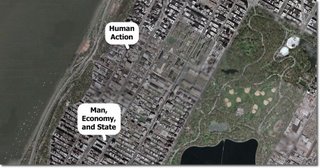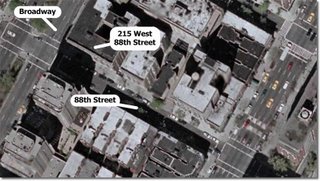
But enough of this footling. History is full of enough examples of the flowering effect of genius to go some way towards explaining this - one thinks immediately of the Socratic chain from Socrates himself, the first murder victim of democracy, through the Lucifer of Plato, towards the resurrection of enlightenment in Aristotle - however, as an Austrian, it is still reverentially exciting to walk the route between the two creation points of two of the greatest books ever written; I now know what it is to be a Christian pilgrim on the road towards Antioch and Jerusalem.

I took the New York subway up from Times Square to 96th Street; this was the typically dispiriting experience of public transport everywhere - escalators weren't working, the staff behind the armoured glass at the help desk didn't want to help, and everything was shabby and dirty - but I was going to get to 777 West End Avenue if it killed me.
Having emerged into the clean sunlight again, I strode up Broadway towards 97th Street and made a left turn. At this point I took an internal thermometer reading to find my heart beating much faster than usual. I was, ridiculously, as excited as a small boy who knows he's getting a bicycle for Christmas; it's a strange thing, the human brain. I could feel the power of religion pulsating through my veins and the mythological significance of the number 777; I finally understood the accusation that we Austrians are just another cultish religion. But what the heck. I walked onwards, turning up the hill towards Mecca and the long-time Manhattan apartment home of Professor Ludwig von Mises and his good lady wife.
And there it was, on the other side of the Avenue, about a hundred yards away up on my left. I stopped to take it in; I was almost too nervous to continue. Here I was, surrounded by millionaires' lackeys rambling with flocks of poodle dogs, and I found myself hitting a force field of insane resistance. Shoulders hunched, I crossed over West End Avenue to begin the assault on the summit. And before I knew it I was there.
By the way, this is the last time I mock Christians who visit the crypt at Bethlehem or the Garden of Gethsemane in Jerusalem; yes, this was simply a pile of bricks on a hill, but this was where Human Action was written.
The numerals of 777 were located about 8 feet off the ground in a small brown serif font, on a cornerstone, and I found the actual entrance to the apartment block itself around the corner on 98th Street, rather than on West End Avenue. The sedate brown entrance awning rippled in an unruffled breeze, resplendent with a cream 777 in the same font type as the cornerstone marking. Time to look upwards.
The building had about 12 floors. As the Professor lived in Apartment 12E, if I’d got my counting right, this placed the creation point of Human Action rather appropriately on the top floor. As befits a Viennese nobleman, the 12th floor was bedecked with some rather ornate decoration topped off with a green copper cornice. Standing outside the front entrance, breaking about 57 local bye-laws on monstering residents, I once again found myself being eyeballed by a small grey-haired doorman, rather unusually one without a hat. The end of 98th street fell away, quite sharply, to my right, down to the Hudson River, which I could spy between the trees; so Von Mises, on leaving the building, would have had access to a little greenery and water to remind him perhaps of Lake Geneva, where the bones of Human Action had been constructed in Nationalökonomie
Okay, so it’s a little melodramatic, but just for a moment I could feel his ghost turning his head to the left to look at the river, as he left the apartment building; I wondered what colour the Hudson was back in the 1950s?
To escape this ghost, I decided to head back down West End Avenue to find the nearby haunt of Uncle Murray Rothbard. Which of the two was the greater genius? I suppose that’s a bit like asking a committed Christian whether God the Father or God the Son was the greater, so I’ll skip the question; I do know, however, that to visit Uncle Murray’s former home was a rare pleasure whereas to visit Professor Mises’ former home was a dutiful pilgrimage. Make of that what you will.
Sloping back down the hill, I threw one last look back to the top floor of 777 West End Avenue, from whence Human Action had emerged, the building still an Arthurian rock on a hill’s crest. Bidding adieu, I then got on with the business of skipping around all the chatting dog handlers to head back towards downtown Manhattan. One street, two streets, nine streets, and I made my left turn. A brisk walk along 88th Street to Broadway and I was almost there. I thought it appropriate that Uncle Murray lived on the corner of Broadway. When the New York government imposed the road grid on Manhattan and confiscated the land for Central Park, one of the only roads to break the planners’ rigid wet dreams was Broadway, which had originally been an Indian trail paved over by the Dutch before the British invaded from the north, breaking through the wooden wall at the southern tip of the island to overrun New Amsterdam.

So Broadway defies the controlling strictures of state imposition and thereby brings a measure of chaotic life and energy to the otherwise moribund grid, creating place, structure, and gaiety, along a tangential axis; you may have heard of 42nd Street but you have definitely heard of Broadway. Yes, this was a very Rothbardian place.
But I got my bearings all wrong, as I approached the Professor’s apartment. Hitting Amsterdam Avenue without finding the number 215, I retraced my steps, and then there it was on the corner of Broadway, with the number on a wall painted over the same creamy colour as the wall. No awning, this time, and no obvious doorman, but it still looked a solid enough building. Uncle Murray’s apartment was 2E and I hoped it was the one right above me, spreading out over the entranceway. I could hear cackling, for some bizarre reason, and felt the shade of a giant imaginary polka-dot bow tie settling over the street. I wondered now who might live behind these brown slatted wooden windows set in a creamy stone wall? Do they know, I thought, who was there before them, and if they did, would they care?
Once upon a time you could have, and often did, squeeze almost every anarcho-capitalist in the world behind the walls of Apartment 2E, 215 West 88th Street, Manhattan, New York. But now, although the pavements aren’t yet teeming with coachloads of us, we probably have enough for a decent sized conference in Hawaii. And it was all due to the efforts of these men, led by Rothbard in the Circle of Bastiat, who made their spiritual home up in this place above me.
Although I never had the privilege of meeting Murray Rothbard, it was enough this day to have made the effort to be there.
And so back into the swamp of the New York public transportation system, at 96th Street, to visit the creation point of Atlas Shrugged.
This had been a very strange and a very good day.
On the train down, I recalled the Mises.org MP3 files by George Reisman and Ralph Raico describing the relations between Rothbard and Rand. What if the bespectacled one had managed to persuade the caped one to become an Austrian and bring all of her fans with her? Where would we be now with our movement? Do we need to somehow generate more Austrian fiction to try to pull more people into our belief in a Totally Voluntary society? Or is Robert Heinlein enough?
Oh well. If I get a good enough novel idea and manage to write it down I’ll let you know. In the meantime I would like to thank my business client this week for giving me the opportunity to visit Manhattan, for providing me with an apartment just off Times Square, and for lending me his limousine to take me to and from the airport.
I may not be a Master of the Universe, but it was nice to have pretended to be one for a few days. And so back to Blighty, the sceptred isle of a thousand shattered dreams to see how Gordon Brown had further wrecked my life with his communist aspiration of state thralldom for all. Roll on the anarcho-capitalist revolution. It can’t come soon enough.
And thanks to Ludwig von Mises and Murray Rothbard it is still possible that it will come. Thank God for both of them.
3 comments:
Dude - I'm jealous! Just marvellous - thanks for sharing that :-)
All I need to do now is present a five-minute skit at Auburn, and I'll have the set! :-)
I wonder if they'd like a monologue on Gordon Brown? Would a three-hour slot be long enough?
Oh well, we live in hope.
Jack, Thanks for that post. I recently visited New York after attending Mises University 2005, but didn't see those landmarks. Perhaps next time.
Post a Comment